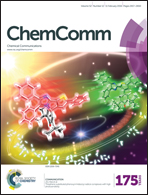Poly(1,2,3-triazolium)s: a new class of functional polymer electrolytes
Abstract
Poly(ionic liquid)s (PILs) are a unique class of polyelectrolytes having properties suited for modern technological applications such as electrochemical devices (batteries, supercapacitors, light-emitting electrochemical cells), ion-gated field effect transistors, electrochromic devices, fuel cells, dye sensitized solar cells, catalysis, or soft robotics. Their structure and properties can be finely tuned by unlimited combinations issued from extended pools of cationic and anionic building blocks. In a constant quest for the development of solid polymer electrolytes with enhanced physical, mechanical and (electro)chemical properties, a new class of PILs based on 1,2,3-triazolium cations has been recently developed. Their preparation takes advantage of the beneficial features of the multiple combinations between the Click chemistry philosophy with macromolecular engineering techniques to afford tunable and highly functional ion conducting materials thus stretching out the actual boundaries of PILs macromolecular design. This feature article summarizes the different strategies developed so far for the synthesis of 1,2,3-triazolium-based PILs (TPILs) since their first introduction in 2013.


 Please wait while we load your content...
Please wait while we load your content...